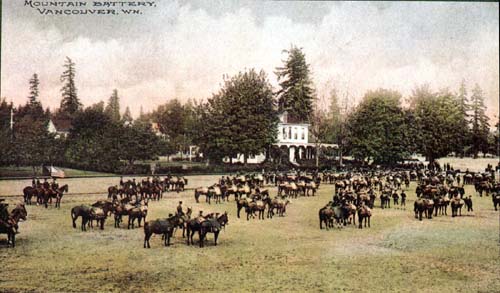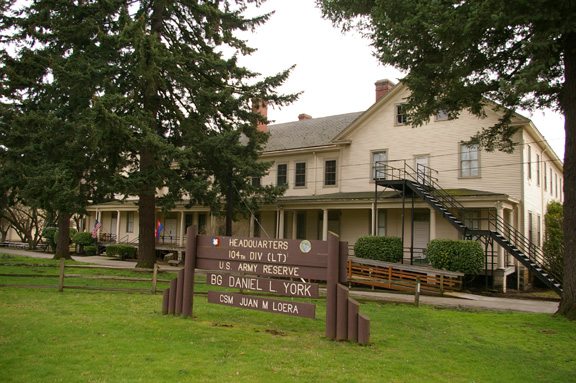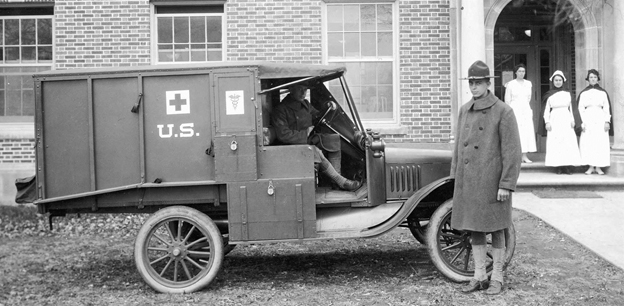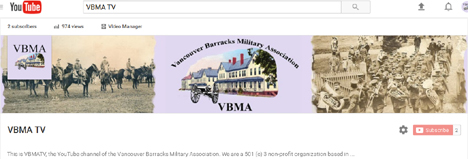Follow this link for more information on our 2017/2018 Ambulance Project
Video about the Ambulance Project
Visit all of our videos on VBMA TV
Vancouver Barracks Military Association
What is the Vancouver Barracks Military Association?
The Vancouver Barracks Military Association (VBMA) was formed by a group of veterans in 2011, and we exist to interpret the past of the Vancouver Barracks. As veterans, we bring our unique perspective to this goal, when working with the many different organizations who share the same goal.
Our meetings are open to anyone and visitors are always welcome.
The Vancouver
Barracks Military Association meetings are held at the 40 et 8 Chateau (7607 NE 26th Ave, Vancouver, WA 98665) on the second Tuesday of the month, from 4:00 - 5:00 PM. The meetings are open to the
public. If you are interested in are interested in attending, please
contact President@vbma.us, or calling
253 223-0125 to let us know of your attendance.

The U.S. Army established The Vancouver Barracks in 1849, and left in 2011. In those 162 or so years, there was a continuous military presence; making the Vancouver Barracks one of the oldest (if not the oldest) U.S. Army post west of the Mississippi River.
In the mid-1800s, the U.S. Army staged several campaigns against various Native American tribes from the Barracks. Service members from the Barracks also helped protect the United States regional claims from other potential enemies, such as the Confederate States of America, Great Britain, and Japan. In the late 1800s, forces from the Vancouver Barracks fought in the South Pacific during the Spanish American War and Philippines Insurrection. In the early 1900s, they fought Pancho Villa's forces along the Mexican Border and brought relief to U.S. Citizens suffering from the devastation of the San Francisco earthquake.
In World War I and World War II, The Vancouver Barracks became a strategic post, rather than a tactical combat arms center. In World War I, most of the spruce wood used by the Allies to make airplanes was milled at the Vancouver Barracks. In World War II, the Barracks became a training center, and port of embarkation for troops and supplies to fight the Axis Forces.
At the end of World War II, the U.S. War Department declared most of the Barracks land surplus and gave or sold it to other entities. They retained only the southern portion of the Barracks and the Post Cemetery at the Northwest corner of the Barracks. From 1946 to 2011, the Vancouver Barracks became a regional center for U.S. Army Reserves and National Guard soldiers to train for military missions, ranging from the Cold War to Korea, to Vietnam, and the Global War on Terrorism. After September 11th 2001, many different units and soldiers deployed out of the Vancouver Barracks.
In the years since the Barracks were founded, many of its soldiers went on to earn awards and fame, or sometimes shame. Like Ulysses S. Grant and Marcus Reno. Other famous alumni of the Barracks include Philip Sheridan, George Pickett, and George C. Marshall.
 In the 60 or so years from 1945 to 2011, one unit became the oldest tenant unit at the Vancouver Barracks, the Headquarters for the 104th Division. The 104th Division was foundedin 1924, from Organized Reserve units in the Western United States. In World War II, it activated and trained at Camp Adair, Oregon before fighting in Europe in 1944 and 1945. In the war, it fought for over 180 days, in continuous contact with the enemy, until VE-Day in May 1945.
In the 60 or so years from 1945 to 2011, one unit became the oldest tenant unit at the Vancouver Barracks, the Headquarters for the 104th Division. The 104th Division was foundedin 1924, from Organized Reserve units in the Western United States. In World War II, it activated and trained at Camp Adair, Oregon before fighting in Europe in 1944 and 1945. In the war, it fought for over 180 days, in continuous contact with the enemy, until VE-Day in May 1945.
Although the 104th Division was inactivated in 1945, it was reactivated in December 1946, and remained at the Vancouver Barracks until it moved to Joint Base Lewis - McChord in 2011. In those years, the 104th Division was at first a Reserve Infantry Division, waiting for combat missions in the early days of the Cold War. Later, it became a unit of trainers, helping other units and their soldiers become ready for any wartime mission. They continue this mission today, across the United States, with Timberwolf Drill Sergeants training entry level soldiers, veteran soldiers as well as ROTC Cadets..
Timeline of Significant Events
| 1804 - 1805 | Lewis and Clark Expedition travel through the Pacific Northwest |
| 1824 | Hudson's Bay Company establishes Fort Vancouver |
| 1837 | Captain Benjamin Bonneville expedition explores the "Oregon Country" and establishes the beginning of the Oregon Trail. Other military expeditions visit the Pacific Northwest and make recommendations about where to make the international border between the United States and British Territories. |
| 1846 | Congress authorizes the U.S. Army to establish military posts along the Oregon Trail to safeguard pioneers |
| 1846 - 1848 | The Mexican - American War delays this plan as U.S. Army troops are sent south to fight. |
| 1848 | Congress creates the Oregon Territory |
| 1849 | Companies L and M, of the 1st Artillery Regiment arrive by ship on 13 May 1849 at the site of the Hudson's Bay Company post of Fort Vancouver to establish a permanent U.S. military presence. They and begin constructing Camp Vancouver, or Camp Columbia.
The main U.S. Army force of Mounted Riflemen travel cross country and arrive on 5 October. Nine wooden structures are built in 1849, including the Grant House. |
| 1850 | Congress passes the Oregon Donation Claim Act, opening up free land to Settlers.
Post name changed to Columbia Barracks. |
| 1851 | Soldiers move into the completed buildings of the Columbia Barracks. |
| 1853 | Name changed to the Fort Vancouver Military Reservation. First Rogue River War |
| 1855 - 1856 | Second Rogue River War |
| 1855 - 1858 | Yakamas War, and conflicts with many other Pacific Northwest Tribes, including the Klickitat, Spokane, Palouse, Nisqually, and many others. |
| 1860 | After several years of shifting their business interests and operations north.
Of the 54th Parallel, the Hudson's Bay Company finally abandon their holdings at Fort Vancouver. |
| 1861 - 1865 | The Civil War saw most of the Regular Army soldiers leaving the Pacific Northwest to fight in the war. A garrison of 50 regulars remain behind, the post is used as a logistical center to support the many volunteer militia garrisons raised, and scattered across the Northwest. Most volunteers garrisons remain on active duty until 1866 |
| 1865 - 1813 | Department of the Columbia is formed with its headquarters at Fort Vancouver, and its territory at one point includes what is now Washington, Oregon, Idaho, parts of Montana and Alaska. At times the headquarters of the Department of the Columbia moves to Portland, it returns to Vancouver, eventually until it is dissolved. |
| 1866 | With the end of the Civil War, Regular Army soldiers begin returning to the Pacific Northwest. Between that time, and 1878, the military presence at Fort Vancouver declines, as do the buildings, as officers and men begin living in more comfortable quarters in Portland, Oregon. |
| 1872 - 1873 | Modoc War |
| 1877 | Nez Perce War |
| 1878 | Bannock and Paiute Wars |
| 1879 | Shoshone War
Post name changed to the Vancouver Barracks |
| 1880 - 1898 | In these years the garrisons at the Vancouver Barracks focus on supporting state, local, and federal authorities in maintaining order in times of civil unrest. |
| 1898 - 1899 | During the Spanish American War, and fighting that followed, soldiers from the Vancouver Barracks staged, and traveled to the Philippines Commander, General Anderson led the invasion force that captured Guam and later, Manila. |
| 1909 - 1996 | Camp Bonneville established |
| 1918 - 1919 | The Spruce Production Division operated the world's largest spruce cut-up mill at the Vancouver Barracks in February 6, 1918 to February 4, 1919. |
| 1925 | Army Airfield established, although the first airplane landing at the Barracks took place in 1905. In 1927, the Itinerary of Stalin landed at Pearson Airfield in the first non-stop transpolar flight ever made. |
| 1933 - 1942 | The U.S. Army garrison at the Vancouver Barracks helps organize the Civilian Conservation Corps within the Pacific Northwest. Then Brigadier General George C. Marshall (1936 - 1937) takes an active part in this activity. |
| 1941 - 1945 | World War II. After Pearl Harbor, the Barracks became a staging area for the Portland Subport of embarkation, where critical goods and personnel were received or shipped out to support the war effort. Lieutenant General Edmund Gregory, the Quartermaster General of the United States Army created a massive new Quartermaster School System at the Vancouver Barracks |
| 1946 | In 1946, after World War II ended and military units were disbanded, the Vancouver Barracks were declared excess to the needs of the Army. A good deal of the military cantonment north of Officer's Row was parceled out to various local or federal agencies |
| 1946 - 2011 | The Headquarters of the 104th Division established at the Vancouver Barracks. The Division Headquarters was reassigned to Joint Base Lewis McChord 2010, the last elements left in 2011 |
Website by Spice Bunny Designs ( spicebunnydesigns@gmail.com )









